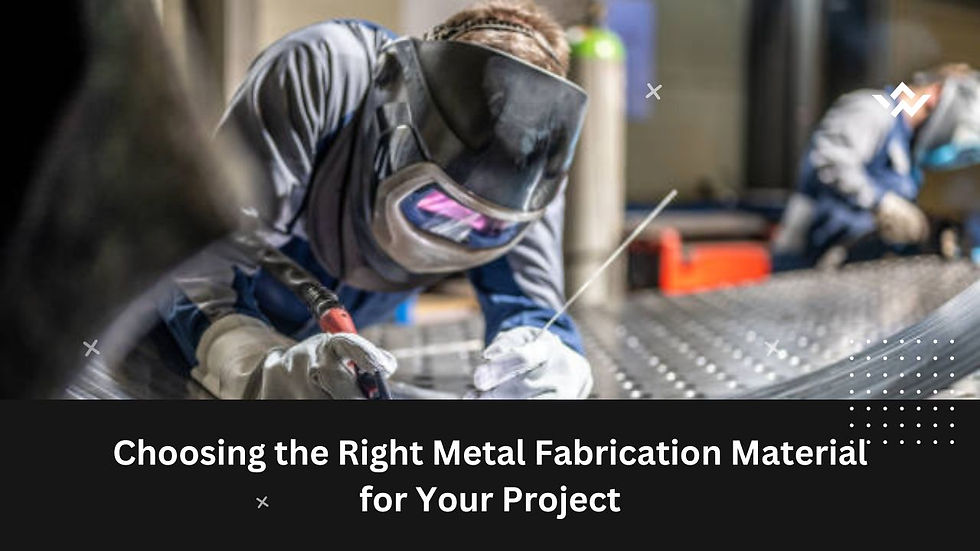Choosing the Right Metal Fabrication Material: Steel vs. Aluminum vs. Copper
- Mark Smith
- Jun 24, 2024
- 2 min read

Choose the Right Metal Fabrication Material
Metal fabrication is a critical process in various industries, from construction to aerospace, where the choice of material can significantly impact the project's success. Among the most common metals used—steel, aluminum, and copper—each offers unique properties and advantages tailored to specific project requirements. Understanding these distinctions is crucial for selecting the optimal material for your metal fabrication project.
Steel: Strength and Versatility
Steel stands out as one of the most widely used metals in fabrication due to its exceptional strength, durability, and versatility. It is primarily composed of iron and carbon, with varying amounts of other elements such as manganese, chromium, and nickel, depending on the specific type.
Properties and Advantages:
Strength: Steel is renowned for its high tensile strength, making it suitable for structural applications where robustness is crucial.
Durability: It exhibits excellent resistance to wear, abrasion, and impact, ensuring longevity in harsh environments.
Versatility: Steel can be easily fabricated into different shapes and sizes, offering flexibility in design and construction.
Applications:
Construction: Used in building frameworks, bridges, and reinforcements.
Automotive: Essential for vehicle chassis and components.
Manufacturing: Ideal for machinery, tools, and equipment requiring strength and reliability.
Aluminum: Lightweight and Corrosion-Resistant
Aluminum is valued for its lightweight nature and corrosion resistance, making it a preferred choice in industries where weight reduction and durability are paramount.
Properties and Advantages:
Lightweight: Aluminum is approximately one-third the weight of steel, making it ideal for applications requiring reduced weight without compromising strength.
Corrosion Resistance: Forms a protective oxide layer that enhances its resistance to corrosion, particularly in marine and outdoor environments.
Conductivity: Excellent thermal and electrical conductivity, suitable for heat exchangers and electrical components.
Applications:
Aerospace: Used in aircraft structures, fuselage panels, and interior components.
Transportation: Essential for manufacturing lightweight vehicles and trailers.
Consumer Goods: Commonly found in household items, such as appliances and furniture.
Copper: Excellent Electrical and Thermal Conductivity
Copper is renowned for its superior electrical and thermal conductivity, making it indispensable in applications where these properties are critical.
Properties and Advantages:
Conductivity: Best-known for its exceptional electrical and thermal conductivity, making it ideal for electrical wiring and heat exchangers.
Malleability: Easily formed into intricate shapes, enhancing its usability in various manufacturing processes.
Corrosion Resistance: Develops a protective patina over time, improving durability in outdoor and marine environments.
Applications:
Electronics: Widely used in circuit boards, motors, and transformers.
Construction: Utilized in roofing, plumbing, and architectural detailing.
Heat Transfer: Essential for cooling systems and renewable energy applications.
Choosing the Right Material for Your Project
When selecting the optimal material for your metal fabrication project, consider the
following factors:
Strength Requirements: Determine the load-bearing capacity and structural demands of your project.
Environmental Conditions: Assess exposure to corrosion, temperature variations, and other environmental factors.
Weight Considerations: Evaluate the importance of weight reduction versus material strength.
Budget and Availability: Factor in material costs, availability, and fabrication complexities.
By understanding the unique properties, advantages, and applications of steel, aluminum, and copper, you can make an informed decision that aligns with your project's specific requirements. Whether you prioritize strength, lightweight construction, or conductivity, each material offers distinct benefits that contribute to successful metal fabrication outcomes.





コメント